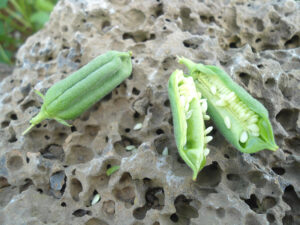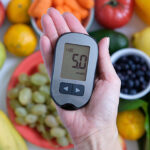SESAME SEEDS

All seeds contain everything required to germinate a new plant and they’re full of energy (kilojoules / Calories) and nutrition for us too. Research suggests seeds have earned their place in nutritious diet for health and longevity. And while seeds contain very little available carbohydrate, they’re high in fibre and healthy fats and have protein so they can help reduce the glycemic impact of the carbohydrates consumed with them.
Sesame seeds are particularly flavoursome. Rich and nutty, they are delicious sprinkled on sweet or savoury baked goods, stir-fry’s, roasts and seafood. Combined with sugar, they make a tasty, crunchy confectionery. Tahini is ground roasted sesame seed paste essential in Middle Eastern cuisine and a key ingredient in hummus (along with chickpeas), baba ghanoush (eggplant dip) and halva (thick, sweet paste). Tahini on toast with a drizzle of honey is a simple breakfast or snack. Sesame seeds have a very high (50%) oil content, and mostly unsaturated fats (both polyunsaturated and monounsaturated). Sesame oil pressed from the seeds adds an intense burst of flavour and is commonly used to finish Chinese and Japanese dishes, and in salad dressings.
Sesame seeds are one of the oldest known oil seed crops and have been produced for 3000 years. They grow in pods that burst when the seeds are ripe. While the most common sesame seeds are pale, there are also black varieties mostly produced in China and southeast Asia and their flavour is even more intense. Black sesame paste is available in Asian grocers, and you can make your own. It’s used as a flavouring in both sweet and savoury dishes. Black sesame ice cream is a classic sushi-train restaurant dessert and also available in Asian grocers (or have a go at making it yourself).
Nutritionally, sesame seeds are high in fibre thanks to each individual seed’s coat, and are just under 20% protein by weight. They also contain iron, magnesium, calcium, vitamin B6, thiamine, copper, and manganese. For such a tiny seed, they pack in a lot of goodness. Use all seeds including sesame seeds in as many ways as you can each day as part of a nutritious balanced diet for a long and healthy life.
| Sesame seeds | |
| 5 Health Stars | |
| Glycemic index | <55 |
| Serving size – 1 tablespoon (11 g or 0.4 oz) | |
| Kilojoules | 290 |
| Calories | 70 |
| Protein (g) | 2.5 |
| Fats (g) – total | 6.2 |
| Includes: – Saturated fat (g) | 0.8 |
| – Monounsaturated fat (g) | 2.6 |
| – Polyunsaturated fat (g) | 2.8 |
| Saturated : unsaturated fat ratio | 0.15 |
| Carbohydrates (g) – Total | 1.8 |
| Available (Includes): | 0.7 |
| –Natural sugars (g) | 0.1 |
| –Natural starches (g) | 0.6 |
| –Added sugars (g) | 0.0 |
| –Added starches (g) | 0.0 |
| Unavailable (Includes): | 1.1 |
| –Dietary fibre (g) | 1.1 |
| Sodium (mg) | 3 |
| Glycemic load (g) | <1 |
| Diabetes exchanges | 0 |
| Ingredients: Sesame seeds |








